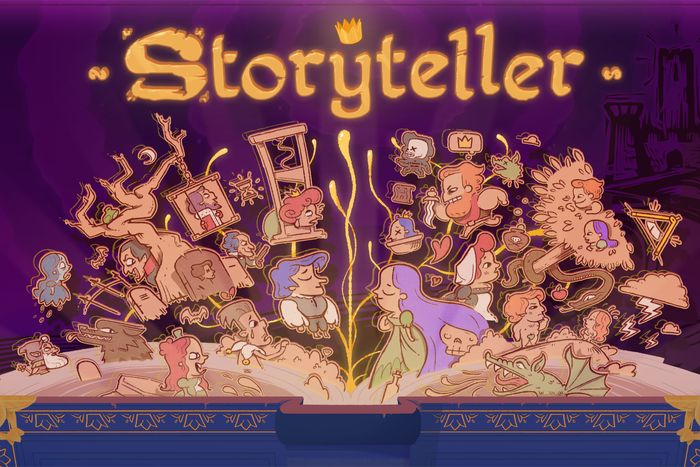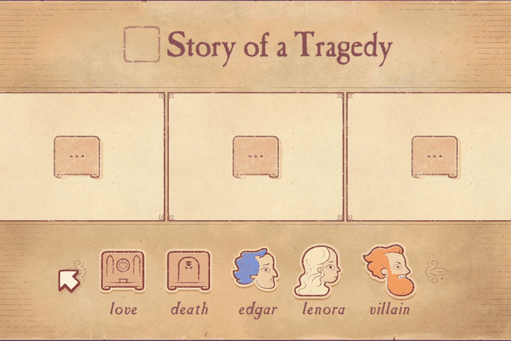
Video-game developer Daniel Benmergui says the most popular speech he ever gave was one called “From Rockstar to Living With Your Mom!” He delivered it at an event called Fuckup Nights, which celebrates tales of failure from founders and creatives, and Benmergui has a corker. The speech is in Spanish, but the story goes like this:
In 2008, he had a million-dollar idea. This was during the “Golden Age” of indie video games, when titles like Fez, Braid, and World Of Goo were minting fortunes for small developers outside of the conventional games-publishing ecosystem. He wanted to make a puzzle game, called Storyteller, that tasked players with creating stories using the visual language of comic strips. One puzzle might call for a simple romance told across two frames. In the first frame, you could drag a character named Adam up, so that he’s standing alone; in the second, you could drag Eve to join him. Success! Now the next puzzle may call for heartbreak. In the first frame, you could have Adam and Eve standing together happily; in the second, remove Eve, and you have a lonely Adam. He cries a little. Heartbreak! Now introduce a mechanic for poison, add a few more frames — you have Romeo & Juliet. Dragging and dropping characters from frames reconfigured the story in real time.
Great idea, right? Benmergui quit his job at a traditional game developer to pursue it full-time. In 2012, a prototype won the prestigious Nuovo Award from the Independent Games Festival, given to a title with groundbreaking mechanics. By this point, Benmergui had run out of money from his old job, so he moved in with his mom, but he felt an incredible sense of momentum and possibility behind Storyteller. “My ego was the size of Jupiter,” he says in the Fuckup Nights talk. He was making connections with other game developers, even crashing at an American developer’s house for three months, and netting press from influential outlets based on little more than a proof of concept.
Then he hit a wall.
“It was too complicated,” Benmergui told me recently. “People couldn’t learn the rules.” As he tried to expand from the couple dozen stories of the original build, he found that the relationships were too complex to guide players through. His earlier games were sketchlike, one-path stories, but Storyteller required user onboarding, sign-posting, difficulty curves — stuff with which he had no experience. So in 2014, after three years of steady, full-time work on his great idea, he put it down. “It was a terrible moment,” he told me.
He started looking for a rebound. After the quagmire of Storyteller, he picked two small projects he planned to finish quickly. He called the first Ernesto: A Quick RPG, as if to limit himself at a conceptual level, but production dragged on for three years, and the game was ultimately never released. Next he turned to the roguelike Fidel Dungeon Rescue, which dragged on for an unexpected three years, and which he says sold poorly upon its release in 2017.
Almost a decade after the lightning-bolt concept of Storyteller struck and made Benmergui indie-game royalty, he was still living with his parents and working out of cafés around Buenos Aires. You can understand why he was drawn to an event called Fuckup Nights. “The window had closed on the golden age of indie video games,” he says in the talk, which he gave in 2020. The market was saturated with similarly quirky, lo-fi game titles.
But Benmergui, ever-cognizant of the power of narrative, ends that Fuckup Nights talk with a twist. After detailing his riches-to-rags story to the audience for 15 minutes, he concludes by revealing on the sly that work on Storyteller had recently begun anew.
It was like a new, empty frame appearing at the end of a tragedy. The smaller, more mechanical games had helped Benmergui build the design confidence to tackle Storyteller’s thornier problems. And, like Archimedes discovering displacement by stopping his work to take a bath, the time away led to a breakthrough.
As with any good puzzle, the solution had been hiding in plain sight. In one of the game’s earliest iterations, the solution to one puzzle is to change the setting from day to night. That one idea — allowing players to determine settings, rather than just characters — ended up being the way Benmergui was able to wrangle the player’s attention (as well as the characters’ motivations), forming scenarios out of clusters of settings. Instead of just dragging and dropping objects, as in the prototype, now they could be placed inside a throne room, a dungeon, a cliff, and so on — all leading to specific types of stories. Now the relationships were predetermined, directional: These two people are having an affair, and that person knows about it. This person is kidnapping that person. It set player expectations about what would happen in each scenario: This person would naturally want to push that person off of the cliff, given their relationship. Work picked up quickly.
A few months after the Fuckup Nights talk, he took everything — the story, the prototypes, the rough idea for a new direction — to Annapurna Interactive, which had begun to make a name for itself as a publisher operating in the “golden age of indie games” spirit, helping small teams and weird games reach broad audiences. “I didn’t really have a pitch,” Benmergui laughs, crediting the years-old IGF award for the publisher’s interest. But he knew — after years working on Storyteller to no avail and sinking three-year chunks into Ernesto and Fidel — that he needed runway.
Seeking support from a publisher felt a bit like heresy to a longtime indie stalwart like Benmergui, but times had changed. “Indie games” were no longer the scrappy movement of the mid-aughts but a commodified genre unto themselves, with their own platforms, trade shows, and even systems. He needed to finish the game with a certain level of scale and polish to stand out. “It was either a publisher,” he says, “or no Storyteller.”
Annapurna’s funding and infrastructure helped Benmergui — well, to move out of his mom’s house, first of all, but also to build a small team, including two additional full-timers and a roster of contractors. (“She misses me,” he says of his mom, surprisingly wistfully. “But she’s fine.”) Together, the new team solved Storyteller’s long-running complexity problem, in part through good old-fashioned polish.
“In Storyteller, you’re following a path of illusion,” Benmergui explains. “If we fuck up even slightly and throw you off the rails, the illusion goes away. Poof! You no longer enjoy the game.” This, he says, is what happened with the alpha version of the game: If individual characters didn’t behave exactly how players expected when, say, a spouse returned after an infidelity, the player would become frustrated. “Some people are going to get stuck on puzzles and say, ‘It’s impossible to solve it.’ That’s fine. The problem is when people think, ‘The way this character behaved makes no sense.’ When that happens, we lost that person forever.”
Tomorrow, some 15 years after the creation of the original prototype, Storyteller will be released to the general public for the ironic price of $14.99 on Nintendo Switch and Steam. It enters a gaming landscape entirely different than it would have in 2008, when its ideas would’ve likely launched a thousand crunchy “design” think pieces. But the widespread acceptance of smaller, more artful games, and the recent success of literary titles like Disco Elysium and Citizen Sleeper, bodes well for Storyteller, particularly in the slow spring months of the game-release calendar.
“I’m a bit numb,” Benmergui says of the notion of the game’s release. “I’ve been told that’s called denial. One of these days I’m going to wake up and have a panic attack because all of this is happening.”
It’s a strange sensation to sit down with a cup or two of coffee and play through a game in a morning that you know constitutes a full third of a person’s life. And yet even without knowing Benmergui’s development saga, the game has an uncommon richness. The humor can be sly and writerly, as in a riff on Beckett or a wicked puzzle called “Cyclic, Mutually Toxic Love Affair.” But it can be emergent: Remove a character’s motivation, and watch a murder instantly transform into a pleasant cliffside hangout. Clicking whole panels out of existence and wildly rearranging narratives in the final stretch feels like slipstreaming through a cartoon multiverse.
It’s the sort of game you recommend quickly to someone who is interested in learning what games can do. While emergent storytelling is not new, and games like the action-puzzler Scribblenauts similarly toy with the idea of narrative as a mechanical possibility space, Storyteller works muscles that I have never felt pulled in a game before, calling on fiction-writing problem-solving that has laid dormant for years. How do I get the queen to fall in love? How do I get the gun in the butler’s hand earlier? It’s an argument in favor of narrative designed not by archetype but by sheer character, as the inevitable result of forces interacting.
Storyteller struck me as the game most deserving of an expansion of any I’d ever played, not because it feels incomplete but because it feels limitless. Benmergui was neither surprised nor distressed by this observation. “Storyteller is a giant tutorial on how to play Storyteller,” he conceded. He expects some calls for a more “sandbox”-style mode, in which players are less constrained by narratives and frameworks, but says that mapping out all those possibilities would require so much additional work that he needed to make sure the demand was out there. He sees particular potential in the “hidden knowledge” mechanic, saying that they designed but did not implement a way for characters to lie to each other.
It’s tempting to see the story of Storyteller as a puzzle from the game: Artist creates prototype in two panels, artist creates masterpiece in 15. (When I asked Benmergui about this, he mentioned a discarded “aging” mechanic from the game, joking that he’d have more gray hair in the last panel.) But of course this isn’t how real life works and speaks more to the magic the game works on the player. When Storyteller’s constrained suggestion of the infinite takes root in your brain, you start to see the panels everywhere, the mechanics in all stories. You stop playing the game, take a look around yourself, and wonder which panel you’re in.





